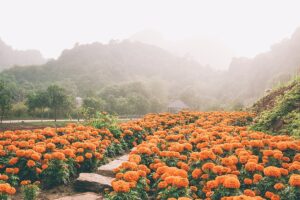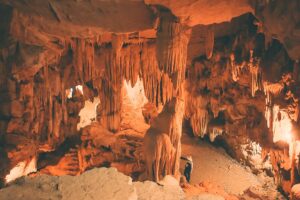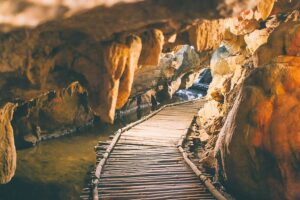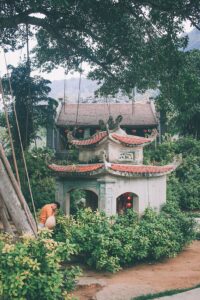Ecotourism has become an increasingly familiar and attractive concept in recent years. It is all about visiting scenic and stunning natural environments with the intention of having minimal impact. In a way, you can see it as the antithesis of the all-too-common experience where once pristine and unique tourist spots evolve into garish parodies filled with strip hotels, night clubs, and souvenir shops.
Which is fine if that is what you are looking for but for many it destroys the very reason for attraction in the first place. That does not mean Eco-tourism should be boring, staid or prudish. The idea is to enjoy, have fun, perhaps learn something with the only caveat being “take only photos and leave only footprints”
Eco Tourism
Thung Nham Bird Park is a great example of eco-tourism done right. Located in the heart of the Trang An World Natural Heritage Complex, the massive joint UNESCO and Vietnamese “experiment” in conservation tourism, Thung Nham consists of several separate types of attractions.
First and foremost Thung Nham Bird Park is, as the name suggests, an 18km² area set aside as a sanctuary and refuge for the many diverse species of both endemic and migratory birds that visit northern South East Asia. Over 50,000 birds and 40+ species use this rich, lush environment home and many more utilize the area as a stop off on their regular migration paths. Of particular note are cranes, storks, bitterns, herons, Eurasian teals, tropical starlings and several endangered species such as the Red Headed Crane, the Lesser Flamingo and the Oriental Pied Hornbill.
The Park is in a large valley that includes several interconnecting lakes encased by undulating limestone mountains. The mountains provide a wind break from the extreme winds this area sometimes experiences while the lakes provide plentiful food, teeming with a large number of aquatic species that are also an important part of the eco-diversity of the region.
Getting Around
There are a number of options for visitors to view the Park. Bicycle riding is a popular choice, along with long walks on the well-marked trails. The path provided is a self-paced 2km long route from the central area and while shade from the luxuriant forest is ever present, visitors are advised to wear suitable footwear, a hat and loose clothing.
The walking route is at the forest’s edge and both sides of the road are covered with tall deciduous trees. After a visit to the lofty bird observatory, the best time to take to the forest is about 4-5 pm, when the cool afternoon winds causes the leaves to tremble like waves against the coast and flocks of birds make the journey back to their nests. The sight of hundreds of large white crane against the evening sky, mixing with pink clouds of sunset is a beautiful natural “dance” that is a wonder to behold.
The bird garden offers visitors a spectacular mountain setting and a chance to get up close and personal with the Vietnamese forests. For those with the time and interest, resort style accommodation is available and as a premier wetland reserve, there is also the option of a guided boat tour which allows you, literally, to get off the “beaten path”.
Note
The birds in the park are “wild” and are free to appear when and where they want. If it is a particularly hot or cold day or out of season for some migratory birds, there will be times that visitors may be disappointed. It is important to choose the right timing but if all else fails, the added attractions of the Bird Park are more than enough to give a visitor their “money’s worth”.
Flora
The central area is an island located in the large lake and besides restaurants, cafes and souvenir shops, hosts an extensive and carefully cultured flower and tree garden. The Vietnamese love of beauty mixed with practicality is in strong evidence here. The flowering gardens proudly “show off” their myriad colors and beauty against the picturesque mountainous forest and are a big draw card for the Park.
Alongside the flower beds is an orchard “rich in fruit trees”, including many exotic fruits such as Jujube berries, star apples, papaya, longan, guava, lychee, pomelo, and other popular Vietnamese produce. The garden’s admission cost includes the fruit, so when in season, visitors may enjoy these wonderful treats for free – just be sure to choose carefully to avoid wastage.
Visitors who are interested in experiencing what it is like to be a farmer can assist in planting new trees and vegetables as well as helping to care for the livestock kept here. While perhaps not a highlight for many foreign guests, it is an experience and education enjoyed by many students and families from the dense urban environment of Hanoi only a 100km or so distant.
Caves
Yet a further added attraction is the Park’s complex of limestone caves.If you have spent any time in Ninh Binh, you will be familiar with the porous limestone karsts pierced everywhere by natural grottoes. For a day trip from Hanoi or for those with limited time, these caves represent the typical topography that abounds in Ninh Binh.
The main caves are Hang Vai Gioi, Hang But and Hang Tien Ca but there are several more if you have the time to explore. Like elsewhere in Ninh Binh, each of these natural ”architectures” are imbued with cultural legends and stories passed down from generation to generation of the local populace. Each cave displays its own unique beauty, and the legends draw inspiration from the Vietnamese people’s beliefs and hopes for a good future.
Hang Vai Gioi
About 200m from the ticket control gate of Thung Nham there is a signpost on the right hand side directing guests to Hang Vai Gioi, the largest cave of the complex. Hang Vai Gioi covers around 5,000 m², and a long, curved stone “staircase” with more than 400 steps leads visitors to the cave entrance. Locals believe it was first discovered it in the 10th century. They also say the place embodies a wild and mysterious “spirit,” like being lost in the “holy land” with Vietnamese “knights” preparing to fight with their cavalry.
The stalagmites and stalactites of most Vietnamese caves are the cause of many of the legends and imbued with significance, like magical creatures to protect the people in a petrified fairy world of creation. The natural formations at Hang Vai Gioi, “abraded” by rain water over centuries, have created a magnificent beauty that according to folk history are like beautiful shining galaxies falling down and “covering the steps” into heaven. A Stairway to Heaven, if you will.
The cave is divided into 3 parts, respectively: Earth, Hell, and Heaven. Because of the size, beauty and mystery of the cave, the locals have a legend that in the past the ancients built an altar to sacrifice to heaven and to pray for favorable weather. Because of this, people named it “Vai Gioi” (the shoulder) and considered it the “intersection” between earth and heaven. They also believe that if you come here and pray sincerely for a dream, the “god of the cave” will hear your prayers and, if your heart is true, may even answer them.
Mermaid Cave
After passing Hang Vai Gioi and the central area of Thung Nham hill – flanked by restaurants, hotels, and souvenir shops – you reach the next cave, Hang Tiên Cá. This smaller cave, about 500 meters long and a “water-cave” which locals call the “Mermaid Cave.”Most caves in Ninh Binh are either “dry” or “wet”. Because Ninh Binh serves as a huge aquifer for the Red River system, water constantly interacts with the soft limestone mountains, creating numerous caves. People describe “wet” caves as those still actively forming, while “dry” caves usually stand higher and appear fully formed.
To fully explore Hang Tiên Cá, the management board have constructed a bamboo “road” so as to better view the splendor of the cave. If spelunking is your interest, it is suggested to bring along a handheld torch and wear non-slip footwear.
According to local legend, people named Hang Tiên Cá after a mermaid who turned to stone following her heartbreak over a lost love with a prince.The magnificence of the “silk strips” of limestone stalagmites and stalactites mixed with the flickering lights produces a vision not unlike the underwater castle of the western deity Poseidon.
In local lore, people have long associated the cave with aquatic themes, seeing the stalactites as representations of colorful coral reefs, dolphins, whales, and of course, mermaids. According to the stories, these fairies gently dance to the ‘piano sounds’ of dripping water, creating a unique musical accompaniment.Walking along the bamboo trail, you can often see schools of Tổng Trường (Climbing Perch) fish swimming in the cave stream – a tasty specialty of the Hoa Lu valleys kings in days gone by.
Hang Bụt
The next cave is Hang Bụt, also a 500m water cavern. Since there’s no boardwalk, visitors must use a boat to enter the cave. However, the administration has chosen not to install a lighting system in order to preserve the cave’s pristine beauty. While guides will have a torch, it is suggest to also bring an extra portable flashlight with you to get the full effect of this “hidden” marvel of geology and topology. Of course Hang But Cave, like its siblings also has a tale surrounding it.
Legend says a benevolent old man once led others here to find a “rich and plentiful” area where they could settle and prosper. In later versions of the story, they reinterpreted the old man as a transformed Buddha who guided them to the right path. Whether just an old man or a Buddha, locals believe you can see him in the stalactites sitting next to the subterranean stream.
Gối Đại Temple
For visitors interested in the history and spirituality of the Vietnamese people, there is also a spiritual location to worship. Gối Đại Temple is located towards the top of the hill, with the much the same construction as other temples in Ninh Binh. Inside, there is a statue of the deity Quốc Mẫu, the Mother goddess of Vietnamese folk religion. The Tran temple in Hoa Lu also worships this goddess, a well-known figure in Vietnamese spirituality.
The cave’s limestone cliffs and mystical beauty astonished those early explorers. So deeply moved, they believed they had entered an unspoiled realm of tropical rain forest. A nirvana type transcendence after extinguishing the fire of greed and achieving a state of pure understanding of the world and universe.
According to locals, the cave also serves as a modest monument to King Dinh Tien Hoang, the local commander who established the first Dai Co Viet kingdom. A small shrine is at the foot of a 1000-year-old banyan tree next to the temple and that locals refer to it as the “fairy tree”. Even if there are wild storms of wind and rain, the tree’s antiquity and shade “protects for the rest of a life” symbolizing the strength of loyalty and keeping memories in mind.
Travel Tips
Guests at Thung Nham gain insight into the conservation and promotion of the essential values that wild mountain nature provides. It is also a lesson and tale about the community and that where ever we live in this modern world, the bridge between the various cultures and indigenous people’s identity remains strong.
Summer hours are 7 am to 6 pm and winter hours are 7:30 a.m. to 5:30 pm and, as stated earlier, the afternoon period between 4 and 6pm is the best time to sight the extensive wildlife of the park. If birds are your main interest (and it is a Bird Park after all) then this is the best time to visit.
Visitors to Thung Nham should remember to pack food and energy drinks as needed, dress comfortably and keep a map of the Park with them at all times. To truly appreciate this location, bug repellent as well as a jacket, hat, and umbrella to protect yourself from the changeable weather are handy.
The cost of admission to the facility is 100k VND pp, the cost of a boat ride to the bird garden is 30k VND pp and the cost of accessing Hang But Cave is 20k VND per person. Admission is free for children under the height of one meter, 10k VND for children between the height of 1 and 1.3m tall while anyone 1.3m tall and above must purchase an adult tickets.
Disabled guests and those aged 80 and above are admitted free of charge. When entering, there is a parking fee of 10-20k VND each motorcycle and for a car 40-50k VND for a car. If you want to mix it up, there are bike rental and fishing services available.






